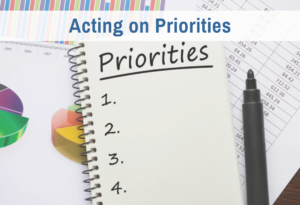Imagine this scenario: Bob is working on manpower estimates for the upcoming year, a big project. Two hours in, when he is deep in the details, his boss drags him away to a meeting with a customer. During the meeting, new ideas for the manpower estimates pop into his head uninvited. He can’t pay attention to them, but they distract him from listening to the customer. They interfere with his remembering details about the customer’s order. He spends the meeting struggling to regain the customer’s context. By the time it’s over, he has lost his place on the manpower estimates and has to redo much of that work.
Do you recognize this frustrating situation?
Fortunately, task-switching doesn’t have to be as wrenching and inefficient as it is in this scenario. The key is, take time for a mental cleanup. Take a few minutes to bring your work to a natural close, make note of where to pick up later, and free your attention for what’s next.
You can clean up at the end of a thinking task by writing down answers to these three questions:
1) What are the takeaways?
2) What are the open issues?
3) What are the next steps?
These three questions help capture the top ideas that are germinating in your mind.
For example, take Bob’s thinking about manpower estimates. Ideas like “we’re booked up for next month” and “we may need to hire someone” and “I still have to investigate XYZ” could be in the back of his mind when the boss interrupts him. By asking the cleanup questions, he could bring these important ideas out into the open. If he wrote them down, he’d have them when he got back to his desk. And by capturing them at once, he would stop them from bubbling up later, in the middle of his meeting with the customer.
Task-switching does reduce your effectiveness. So avoid it when you can.
But when you have to switch tasks, take a few minutes to clean up your ideas from the first task before starting the second. That will make the transition as painless as possible—and help you use your time on both tasks more effectively.








0 Comments